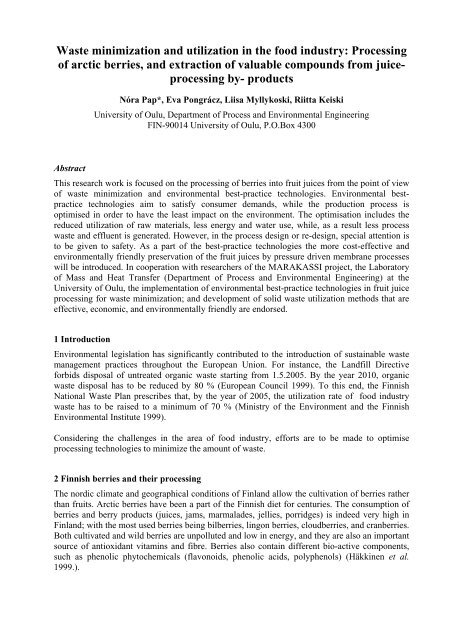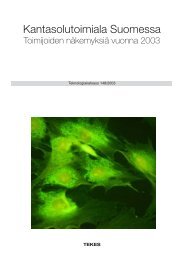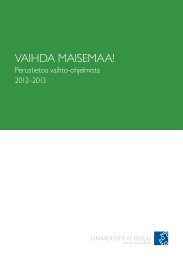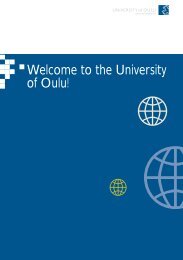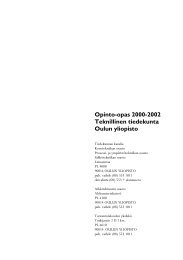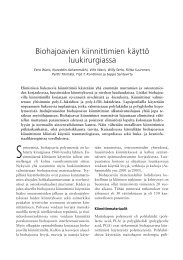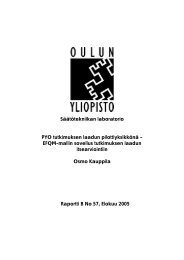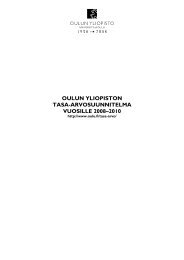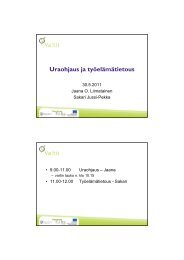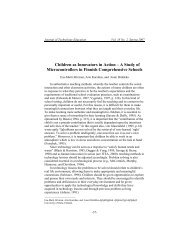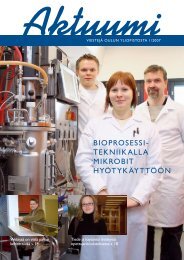Waste minimization and utilization in the food industry: Processing of ...
Waste minimization and utilization in the food industry: Processing of ...
Waste minimization and utilization in the food industry: Processing of ...
You also want an ePaper? Increase the reach of your titles
YUMPU automatically turns print PDFs into web optimized ePapers that Google loves.
<strong>Waste</strong> <strong>m<strong>in</strong>imization</strong> <strong>and</strong> <strong>utilization</strong> <strong>in</strong> <strong>the</strong> <strong>food</strong> <strong>in</strong>dustry: Process<strong>in</strong>g<br />
<strong>of</strong> arctic berries, <strong>and</strong> extraction <strong>of</strong> valuable compounds from juiceprocess<strong>in</strong>g<br />
by- products<br />
Nóra Pap*, Eva Pongrácz, Liisa Myllykoski, Riitta Keiski<br />
University <strong>of</strong> Oulu, Department <strong>of</strong> Process <strong>and</strong> Environmental Eng<strong>in</strong>eer<strong>in</strong>g<br />
FIN-90014 University <strong>of</strong> Oulu, P.O.Box 4300<br />
Abstract<br />
This research work is focused on <strong>the</strong> process<strong>in</strong>g <strong>of</strong> berries <strong>in</strong>to fruit juices from <strong>the</strong> po<strong>in</strong>t <strong>of</strong> view<br />
<strong>of</strong> waste <strong>m<strong>in</strong>imization</strong> <strong>and</strong> environmental best-practice technologies. Environmental bestpractice<br />
technologies aim to satisfy consumer dem<strong>and</strong>s, while <strong>the</strong> production process is<br />
optimised <strong>in</strong> order to have <strong>the</strong> least impact on <strong>the</strong> environment. The optimisation <strong>in</strong>cludes <strong>the</strong><br />
reduced <strong>utilization</strong> <strong>of</strong> raw materials, less energy <strong>and</strong> water use, while, as a result less process<br />
waste <strong>and</strong> effluent is generated. However, <strong>in</strong> <strong>the</strong> process design or re-design, special attention is<br />
to be given to safety. As a part <strong>of</strong> <strong>the</strong> best-practice technologies <strong>the</strong> more cost-effective <strong>and</strong><br />
environmentally friendly preservation <strong>of</strong> <strong>the</strong> fruit juices by pressure driven membrane processes<br />
will be <strong>in</strong>troduced. In cooperation with researchers <strong>of</strong> <strong>the</strong> MARAKASSI project, <strong>the</strong> Laboratory<br />
<strong>of</strong> Mass <strong>and</strong> Heat Transfer (Department <strong>of</strong> Process <strong>and</strong> Environmental Eng<strong>in</strong>eer<strong>in</strong>g) at <strong>the</strong><br />
University <strong>of</strong> Oulu, <strong>the</strong> implementation <strong>of</strong> environmental best-practice technologies <strong>in</strong> fruit juice<br />
process<strong>in</strong>g for waste <strong>m<strong>in</strong>imization</strong>; <strong>and</strong> development <strong>of</strong> solid waste <strong>utilization</strong> methods that are<br />
effective, economic, <strong>and</strong> environmentally friendly are endorsed.<br />
1 Introduction<br />
Environmental legislation has significantly contributed to <strong>the</strong> <strong>in</strong>troduction <strong>of</strong> susta<strong>in</strong>able waste<br />
management practices throughout <strong>the</strong> European Union. For <strong>in</strong>stance, <strong>the</strong> L<strong>and</strong>fill Directive<br />
forbids disposal <strong>of</strong> untreated organic waste start<strong>in</strong>g from 1.5.2005. By <strong>the</strong> year 2010, organic<br />
waste disposal has to be reduced by 80 % (European Council 1999). To this end, <strong>the</strong> F<strong>in</strong>nish<br />
National <strong>Waste</strong> Plan prescribes that, by <strong>the</strong> year <strong>of</strong> 2005, <strong>the</strong> <strong>utilization</strong> rate <strong>of</strong> <strong>food</strong> <strong>in</strong>dustry<br />
waste has to be raised to a m<strong>in</strong>imum <strong>of</strong> 70 % (M<strong>in</strong>istry <strong>of</strong> <strong>the</strong> Environment <strong>and</strong> <strong>the</strong> F<strong>in</strong>nish<br />
Environmental Institute 1999).<br />
Consider<strong>in</strong>g <strong>the</strong> challenges <strong>in</strong> <strong>the</strong> area <strong>of</strong> <strong>food</strong> <strong>in</strong>dustry, efforts are to be made to optimise<br />
process<strong>in</strong>g technologies to m<strong>in</strong>imize <strong>the</strong> amount <strong>of</strong> waste.<br />
2 F<strong>in</strong>nish berries <strong>and</strong> <strong>the</strong>ir process<strong>in</strong>g<br />
The nordic climate <strong>and</strong> geographical conditions <strong>of</strong> F<strong>in</strong>l<strong>and</strong> allow <strong>the</strong> cultivation <strong>of</strong> berries ra<strong>the</strong>r<br />
than fruits. Arctic berries have been a part <strong>of</strong> <strong>the</strong> F<strong>in</strong>nish diet for centuries. The consumption <strong>of</strong><br />
berries <strong>and</strong> berry products (juices, jams, marmalades, jellies, porridges) is <strong>in</strong>deed very high <strong>in</strong><br />
F<strong>in</strong>l<strong>and</strong>; with <strong>the</strong> most used berries be<strong>in</strong>g bilberries, l<strong>in</strong>gon berries, cloudberries, <strong>and</strong> cranberries.<br />
Both cultivated <strong>and</strong> wild berries are unpolluted <strong>and</strong> low <strong>in</strong> energy, <strong>and</strong> <strong>the</strong>y are also an important<br />
source <strong>of</strong> antioxidant vitam<strong>in</strong>s <strong>and</strong> fibre. Berries also conta<strong>in</strong> different bio-active components,<br />
such as phenolic phytochemicals (flavonoids, phenolic acids, polyphenols) (Häkk<strong>in</strong>en et al.<br />
1999.).
It has been established that consumption <strong>of</strong> fruits rich <strong>in</strong> phytochemicals helps to avoid coronary<br />
heart disease (Hertog et al. 1993), stroke (Keli et al. 1996) <strong>and</strong> lung cancer (Knekt et al. 1997).<br />
Notable are also <strong>the</strong> antibacterial properties <strong>of</strong> berries. The cloudberry (Rubus chamaemorus),<br />
raspberry (Rubus idaeus), <strong>and</strong> bilberry (Vacc<strong>in</strong>ium myrtillus) <strong>and</strong> crowberry (Empetrum nigrum)<br />
were effective aga<strong>in</strong>st all <strong>of</strong> <strong>the</strong> bacterial stra<strong>in</strong>s tested. Bog bilberry (V. ulig<strong>in</strong>osum) <strong>in</strong>hibited all<br />
<strong>the</strong> gram-positive bacteria, but not gram-negative E . coli, S . aureus, B . subtilis <strong>and</strong> M.luteus<br />
(Rauha et al. 2000). Figure 1 shows <strong>the</strong> flavonoid content <strong>of</strong> different F<strong>in</strong>nish berries.<br />
Figure 1 Flavonol content <strong>of</strong> F<strong>in</strong>nish berries (Häkk<strong>in</strong>en et al. 1999)<br />
In <strong>the</strong> follow<strong>in</strong>g, <strong>the</strong> pr<strong>in</strong>ciples <strong>of</strong> waste <strong>m<strong>in</strong>imization</strong> will be <strong>in</strong>troduced <strong>and</strong> <strong>the</strong> critical po<strong>in</strong>ts<br />
<strong>of</strong> fruit juice process<strong>in</strong>g from <strong>the</strong> perspective <strong>of</strong> waste generation will be analysed. As an<br />
example for clean processes, a complex method for fruit juice concentrate production has been<br />
carried out by application <strong>of</strong> membrane technology.<br />
3 <strong>Waste</strong> <strong>m<strong>in</strong>imization</strong> <strong>in</strong> <strong>the</strong> waste management hierarchy<br />
The primary aim <strong>of</strong> waste legislation is <strong>the</strong> prevention <strong>of</strong> waste generation. <strong>Waste</strong> prevention<br />
refers to three types <strong>of</strong> practical actions, i.e., strict avoidance, reduction at source, <strong>and</strong> product<br />
re-use. However, waste prevention does not only <strong>in</strong>clude <strong>the</strong> reduction <strong>of</strong> absolute waste<br />
amounts but also avoidance <strong>of</strong> hazards <strong>and</strong> risks because safety is also <strong>of</strong> major concern.<br />
Consider<strong>in</strong>g <strong>the</strong> waste management options, at <strong>the</strong> top <strong>of</strong> <strong>the</strong> hierarchy st<strong>and</strong>s waste<br />
<strong>m<strong>in</strong>imization</strong> that <strong>in</strong>cludes (Riemer & Krist<strong>of</strong>fersen 1999):<br />
• waste prevention i.e. reduction <strong>of</strong> waste by application <strong>of</strong> more efficient production<br />
technologies;<br />
• <strong>in</strong>ternal recycl<strong>in</strong>g <strong>of</strong> production waste;<br />
• source-oriented improvement <strong>of</strong> waste quality, e.g. substitution <strong>of</strong> hazardous substances;<br />
• re-use <strong>of</strong> products or parts <strong>of</strong> products, for <strong>the</strong> same or o<strong>the</strong>r purpose.<br />
Figure 2 illustrates <strong>the</strong> position <strong>of</strong> <strong>the</strong> European Environmental Agency (EEA) on waste<br />
<strong>m<strong>in</strong>imization</strong>.
<strong>Waste</strong> M<strong>in</strong>imisation<br />
Def<strong>in</strong>ition Cleaner Production/<br />
<strong>Waste</strong> M<strong>in</strong>imisation<br />
Prevention<br />
Reduction at Source<br />
Re-Use <strong>of</strong> Products<br />
for same purpose<br />
Disassembl<strong>in</strong>g <strong>of</strong><br />
Complex Products <strong>and</strong><br />
Re-Use <strong>of</strong> Components<br />
for <strong>the</strong> same Purpose<br />
Re-Use <strong>of</strong> Products<br />
for o<strong>the</strong>r Purposes<br />
On-Site Recycl<strong>in</strong>g<br />
Source-oriented <strong>Waste</strong><br />
Quality Improvements<br />
Off-Site Recycl<strong>in</strong>g<br />
<strong>Waste</strong>-oriented <strong>Waste</strong><br />
Quality Improvements<br />
Pre- treatment<br />
Energy recovery<br />
Preventive Measures<br />
<strong>Waste</strong> Management Measures<br />
Figure 2 <strong>Waste</strong> <strong>m<strong>in</strong>imization</strong> vs. waste management measures (Riemer & Krist<strong>of</strong>fersen 1999)<br />
4 The environmental impacts <strong>of</strong> <strong>the</strong> <strong>food</strong> sector<br />
While it is true that <strong>the</strong> pr<strong>in</strong>ciple <strong>of</strong> waste prevention is universally accepted, <strong>the</strong> practice has<br />
lagged far beh<strong>in</strong>d. Food <strong>in</strong>dustry will also have to concentrate on waste avoidance as well as<br />
<strong>utilization</strong> <strong>of</strong> process wastes. Application <strong>of</strong> clean technologies enhances <strong>the</strong> safety <strong>and</strong> quality<br />
<strong>of</strong> <strong>the</strong> product as well as reduc<strong>in</strong>g <strong>the</strong> energy requirements <strong>and</strong> environmental impact <strong>of</strong> <strong>the</strong> <strong>food</strong><br />
<strong>in</strong>dustry. The ma<strong>in</strong> environmental impacts <strong>of</strong> <strong>the</strong> <strong>food</strong> sector are aquatic, atmospheric <strong>and</strong> solid<br />
waste emissions. By choos<strong>in</strong>g proper separation technology, wastewater treatment is usually<br />
carried out <strong>and</strong> is implemented <strong>in</strong> process <strong>in</strong>stallations. The atmospheric emissions are ma<strong>in</strong>ly<br />
caused by extensive energy use. The <strong>food</strong> <strong>in</strong>dustry consumes a great deal <strong>of</strong> energy for heat<strong>in</strong>g<br />
build<strong>in</strong>gs, processes, <strong>and</strong> process water, for refrigeration <strong>and</strong> for <strong>the</strong> transportation <strong>of</strong> raw<br />
materials <strong>and</strong> products. The <strong>in</strong>creased share <strong>of</strong> renewable energy sources could slowly reduce <strong>the</strong><br />
amount <strong>of</strong> conventional fossil fuel <strong>utilization</strong>.<br />
Solid by-products <strong>and</strong> wastes are also generated <strong>in</strong> high amounts <strong>in</strong> <strong>the</strong> <strong>food</strong> <strong>in</strong>dustry. The ma<strong>in</strong><br />
treatment method <strong>of</strong> solid wastes is, at present, compost<strong>in</strong>g. Recovery <strong>and</strong> re-use <strong>of</strong> by-products<br />
<strong>and</strong> wastes as raw materials is ano<strong>the</strong>r option. However, microbiological quality <strong>and</strong> safety is<br />
always <strong>of</strong> major concern.<br />
4.1 Analysis <strong>of</strong> fruit process<strong>in</strong>g <strong>and</strong> evaluation <strong>of</strong> waste <strong>m<strong>in</strong>imization</strong> potential<br />
From an environmental po<strong>in</strong>t <strong>of</strong> view, process<strong>in</strong>g <strong>of</strong> berries produces large amounts <strong>of</strong> effluents<br />
<strong>and</strong> solid waste. In fruit juice process<strong>in</strong>g large amounts <strong>of</strong> water are used, ma<strong>in</strong>ly for clean<strong>in</strong>g<br />
purposes. Due to hygienic <strong>and</strong> <strong>food</strong> safety considerations, most <strong>of</strong> <strong>the</strong> utilized water is dr<strong>in</strong>k<strong>in</strong>g<br />
water quality <strong>and</strong> <strong>the</strong> amount <strong>of</strong> water effluent can be up to 10 m 3 /tonnes <strong>of</strong> raw material. The<br />
water is used for raw material wash<strong>in</strong>g, plant <strong>and</strong> equipment clean<strong>in</strong>g, <strong>and</strong> o<strong>the</strong>r <strong>in</strong>dustrial<br />
<strong>utilization</strong>. The resultant wastewater has a high organic content, conta<strong>in</strong><strong>in</strong>g parts <strong>of</strong> <strong>the</strong> fruits,<br />
clean<strong>in</strong>g agents, salts <strong>and</strong> suspended solids.
As <strong>the</strong> amount <strong>and</strong> quality <strong>of</strong> <strong>the</strong> effluent greatly <strong>in</strong>fluences <strong>the</strong> economic feasibility <strong>of</strong> a<br />
company, efforts should be made to m<strong>in</strong>imize <strong>the</strong> use <strong>of</strong> water <strong>and</strong> <strong>the</strong>refore to (World Bank<br />
1996):<br />
• use dry methods such as vibration or air jets to clean raw fruit;<br />
• separate <strong>and</strong> re-circulate process wastewaters;<br />
• m<strong>in</strong>imize <strong>the</strong> use <strong>of</strong> water for clean<strong>in</strong>g purposes;<br />
• remove solid wastes without <strong>the</strong> use <strong>of</strong> water; <strong>and</strong><br />
• use counter-current systems where wash<strong>in</strong>g is necessary.<br />
Solid wastes usually orig<strong>in</strong>ate from pre-treatment – wash<strong>in</strong>g <strong>and</strong> sort<strong>in</strong>g –, <strong>and</strong> <strong>the</strong>y consist <strong>of</strong><br />
damaged fruits, stems <strong>and</strong> stalks. A major source <strong>of</strong> solid waste generation is <strong>the</strong> press<strong>in</strong>g<br />
process, <strong>in</strong> which peels, seeds, pulps are separated from <strong>the</strong> fruit juice. There is a large unused<br />
potential <strong>in</strong> <strong>the</strong> juice process<strong>in</strong>g wastes, as <strong>the</strong>y conta<strong>in</strong> a sizeable amount <strong>of</strong> healthy substances,<br />
such as flavonoids, colours <strong>and</strong> pect<strong>in</strong>s.<br />
F<strong>in</strong>l<strong>and</strong>’s gross value <strong>of</strong> fruit <strong>and</strong> vegetable juice production was €120.6 million <strong>in</strong> 2001 (F<strong>in</strong>nish<br />
Food <strong>and</strong> Dr<strong>in</strong>k Industries’ Federation statistical review 2003). Accord<strong>in</strong>g to <strong>the</strong> H<strong>and</strong>book for<br />
<strong>the</strong> prevention <strong>and</strong> <strong>m<strong>in</strong>imization</strong> <strong>of</strong> waste <strong>and</strong> valorisation <strong>of</strong> by-products <strong>in</strong> European agro-<strong>food</strong><br />
<strong>in</strong>dustries (2002), <strong>the</strong> amount <strong>of</strong> solid waste from generated <strong>in</strong> juice process<strong>in</strong>g is 121 911 t/<br />
year.<br />
The F<strong>in</strong>nish MARAKASSI project, co-ord<strong>in</strong>ated by Viikki Food Centre at <strong>the</strong> University <strong>of</strong><br />
Hels<strong>in</strong>ki, <strong>in</strong>itialized a network <strong>of</strong> small- <strong>and</strong> medium-sized berry, vegetable <strong>and</strong> mushroom<br />
process<strong>in</strong>g companies. The project is f<strong>in</strong>anced by <strong>the</strong> European Agricultural Guidance <strong>and</strong><br />
Guarantee Fund <strong>and</strong>, <strong>in</strong> its <strong>in</strong>itial stage, mapped <strong>the</strong> technology development needs <strong>of</strong><br />
participat<strong>in</strong>g companies. One <strong>of</strong> <strong>the</strong> f<strong>in</strong>d<strong>in</strong>gs <strong>of</strong> <strong>the</strong> MARAKASSI project was that member<br />
companies are <strong>in</strong>creas<strong>in</strong>gly fac<strong>in</strong>g <strong>the</strong> problem <strong>of</strong> <strong>the</strong> treatment <strong>and</strong> disposal <strong>of</strong> solid waste from<br />
<strong>food</strong> process<strong>in</strong>g. For example, <strong>the</strong> sk<strong>in</strong>s <strong>of</strong> potatoes are a source <strong>of</strong> problems, <strong>and</strong> potato<br />
process<strong>in</strong>g companies are <strong>in</strong>terested <strong>in</strong> <strong>the</strong> development <strong>of</strong> <strong>utilization</strong> pathways to elim<strong>in</strong>ate<br />
soluble starch from wastewater, as <strong>the</strong>y tend to clog <strong>the</strong> pipes (Marakassi 2002)<br />
Ano<strong>the</strong>r perceived <strong>in</strong>novative technology development need is called upon for <strong>the</strong> <strong>utilization</strong> <strong>of</strong><br />
solid wastes from <strong>the</strong> juice press<strong>in</strong>g operation. The rema<strong>in</strong><strong>in</strong>g waste after <strong>the</strong> berry press<strong>in</strong>g <strong>and</strong><br />
separation process steps, i.e. peels <strong>and</strong> seeds, do conta<strong>in</strong> valuable compounds such as flavonoids<br />
or aromatic oils. When apply<strong>in</strong>g proper extraction technology, i.e. super-critical fluid extraction,<br />
<strong>the</strong>se healthy compounds can be recovered <strong>and</strong> applied ei<strong>the</strong>r by <strong>the</strong> <strong>food</strong> <strong>in</strong>dustry, or <strong>the</strong><br />
cosmetic or pharmaceutical <strong>in</strong>dustries.<br />
5 Application <strong>of</strong> membrane processes for waste <strong>m<strong>in</strong>imization</strong><br />
Membrane technology is based on a th<strong>in</strong> physical barrier through which materials can ei<strong>the</strong>r pass<br />
(<strong>the</strong> permeate) or be rejected <strong>and</strong> reta<strong>in</strong>ed (<strong>the</strong> retentate) due to a driv<strong>in</strong>g force that can be<br />
pressure difference, concentration gradient, temperature gradient, <strong>and</strong>/or electrical potential<br />
difference. Appropriately-used membrane separation can provide f<strong>in</strong>ancial sav<strong>in</strong>gs <strong>and</strong> conserve<br />
resources. Maximum benefits are obta<strong>in</strong>ed when one or both <strong>the</strong> output streams from <strong>the</strong><br />
membrane system are recycled or re-used, <strong>the</strong>reby reduc<strong>in</strong>g process materials requirement <strong>and</strong><br />
m<strong>in</strong>imis<strong>in</strong>g waste disposal costs. Compared with conventional process<strong>in</strong>g, membrane technology<br />
has many advantages. By implement<strong>in</strong>g membranes, <strong>the</strong> separated substances are <strong>of</strong>ten<br />
recoverable <strong>in</strong> a chemically unchanged form <strong>and</strong> are <strong>the</strong>refore easily re-used. Membrane<br />
separation units are compact <strong>and</strong> <strong>the</strong>ir modular construction means that <strong>the</strong>y can be scaled up or<br />
down easily.
Membrane filtration processes <strong>of</strong>fer new ways <strong>of</strong> <strong>food</strong> process<strong>in</strong>g to fulfil <strong>the</strong> consumer dem<strong>and</strong><br />
for healthy <strong>food</strong> rich <strong>in</strong> valuable components <strong>and</strong> preserved without chemical additives. With <strong>the</strong><br />
application, <strong>the</strong> process becomes simpler, shorter <strong>and</strong> takes place at lower temperatures,<br />
<strong>the</strong>refore <strong>the</strong> valuable <strong>and</strong> heat-sensitive compounds are not lost to any great extent. State-<strong>of</strong>-<strong>the</strong>art<br />
membrane technology methods <strong>of</strong>fer <strong>the</strong> possibility to enhance <strong>food</strong> safety, <strong>and</strong> reduce <strong>the</strong><br />
energy consumption <strong>and</strong> <strong>the</strong> environmental impact <strong>of</strong> <strong>food</strong> process<strong>in</strong>g. Membrane separations<br />
are applied:<br />
• concentration (removal <strong>of</strong> a dilut<strong>in</strong>g solvent such as water);<br />
• purification (separation <strong>of</strong> contam<strong>in</strong>ants);<br />
• fractionation (resolution <strong>in</strong>to two or more component substances).<br />
The pressure driven membrane processes are divided based on <strong>the</strong> membrane pore size to:<br />
• micro-filtration (0.1-10 µm)<br />
• ultra-filtration (0.01-0.1 µm)<br />
• nano-filtration (1-10 nm)<br />
• reverse osmosis (0.1-1 nm)<br />
Typical <strong>food</strong> <strong>in</strong>dustrial applications <strong>of</strong> micro-filtration are:<br />
• cold sterilization <strong>of</strong> beverages<br />
• clarification <strong>of</strong> fruit juices, beers <strong>and</strong> w<strong>in</strong>es<br />
• cont<strong>in</strong>uous fermentation<br />
• separation <strong>of</strong> oil- water emulsions<br />
• wastewater treatment<br />
Applications <strong>of</strong> ultra-filtration are:<br />
• concentration <strong>of</strong> milk<br />
• recovery <strong>of</strong> whey prote<strong>in</strong>s<br />
• recovery <strong>of</strong> potato starch <strong>and</strong> prote<strong>in</strong>s<br />
• concentration <strong>of</strong> egg<br />
• clarification <strong>of</strong> fruit juices <strong>and</strong> alcoholic beverages.<br />
Ma<strong>in</strong> application <strong>of</strong> nano-filtration:<br />
• removal <strong>of</strong> micro-pollutants<br />
• water s<strong>of</strong>ten<strong>in</strong>g<br />
• wastewater treatment.<br />
Typically reverse osmosis is used <strong>in</strong>:<br />
• desal<strong>in</strong>ation<br />
• concentration <strong>of</strong> <strong>food</strong> juice <strong>and</strong> sugars<br />
• concentration <strong>of</strong> milk.<br />
When operat<strong>in</strong>g a membrane system, optimal conditions should be found. The measurement <strong>of</strong><br />
<strong>the</strong> process efficiency can be <strong>the</strong> selectivity <strong>and</strong> <strong>the</strong> permeate flux. Flux is typically expressed as<br />
volume or mass per unit membrane area per unit time, for example litres/m 2 /hour. Temperature<br />
can affect flux significantly. Operat<strong>in</strong>g at high flux levels means that less membrane area is<br />
required <strong>and</strong> economies can be made <strong>in</strong> terms <strong>of</strong> capital, operat<strong>in</strong>g <strong>and</strong> membrane replacement<br />
costs.
5.1 Juice concentration with membranes<br />
Preservation <strong>of</strong> fruit juices also contributes to waste <strong>m<strong>in</strong>imization</strong> by <strong>the</strong> means <strong>of</strong> avoid<strong>in</strong>g <strong>the</strong><br />
spoilage <strong>of</strong> <strong>the</strong> product. The traditional preservation methods are based <strong>the</strong> addition <strong>of</strong> chemicals<br />
or physical methods such as pasteurisation, evaporation. Compar<strong>in</strong>g to <strong>the</strong> evaporation, which is<br />
widely used for fruit juice concentrate production, energy efficiency is <strong>of</strong> great importance. The<br />
end- product is clean <strong>and</strong> <strong>of</strong> good quality, while <strong>the</strong> by-product <strong>of</strong> <strong>the</strong> f<strong>in</strong>al concentration step is<br />
a clear water that can be re-used <strong>in</strong> a process, e.g. for <strong>the</strong> first r<strong>in</strong>se <strong>of</strong> <strong>the</strong> berry fruits or for floor<br />
wash<strong>in</strong>g purposes.<br />
A complex method based on pressure-driven membrane technologies was carried out for grape<br />
juice process<strong>in</strong>g (Figure 3) at Szent István University, Department <strong>of</strong> Food Eng<strong>in</strong>eer<strong>in</strong>g (Pap<br />
2003). A two-stage process resulted <strong>in</strong> a fruit juice concentrate, while <strong>the</strong> valuable compounds<br />
were reta<strong>in</strong>ed <strong>in</strong> <strong>the</strong> juice.<br />
Sterilization<br />
Clarification<br />
Concentration<br />
Preservation<br />
Clear Water<br />
Must<br />
MF<br />
RO<br />
Permeate<br />
W<strong>in</strong>ery<br />
Conc.<br />
S<strong>of</strong>t dr<strong>in</strong>k<br />
<strong>in</strong>dustry<br />
Customer<br />
New product: "Bio syrup"<br />
Figure 3 Complex method for fruit juice process<strong>in</strong>g (Pap 2003)<br />
As a first step, micro-filtration was applied as a pre-treatment for clarification <strong>and</strong> sterilisation <strong>of</strong><br />
juice samples. Microbiological experiments <strong>and</strong> sensory analysis was carried out to prove <strong>the</strong><br />
efficiency <strong>of</strong> <strong>the</strong> process step. Based on <strong>the</strong> microbiological experiments on YEPD sterile<br />
medium that allows <strong>the</strong> growth <strong>of</strong> all types <strong>of</strong> micro-organisms, a 6 order <strong>of</strong> magnitude decrease<br />
<strong>in</strong> <strong>the</strong> total cell number was achieved.<br />
Independent analysers performed pr<strong>of</strong>ile analysis <strong>of</strong> micro-filtered juice samples. They analysed<br />
<strong>the</strong> taste <strong>and</strong> smell <strong>of</strong> grape juice samples. The analysis took place <strong>in</strong> a special laboratory, where<br />
<strong>the</strong> analysers were seated <strong>in</strong> separate cubicles <strong>and</strong> performed <strong>the</strong> evaluation aided by a computer<br />
programme. The follow<strong>in</strong>g effects were observed on <strong>the</strong> juice properties after clarification (Pap<br />
2003):<br />
• Loss <strong>of</strong> <strong>the</strong> orig<strong>in</strong>al taste <strong>and</strong> smell to a certa<strong>in</strong> extent;<br />
• The appearance <strong>of</strong> <strong>the</strong> filtered musts was enhanced;<br />
• Due to lower side taste <strong>in</strong>tensity, <strong>the</strong> taste <strong>of</strong> <strong>the</strong> treated samples was preferred.<br />
As a next process<strong>in</strong>g step, reverse osmosis was applied for concentration, i.e. preservation <strong>of</strong> <strong>the</strong><br />
fruit juice. Dur<strong>in</strong>g <strong>the</strong> filtration procedure, water is removed from <strong>the</strong> juice as permeate; while<br />
<strong>the</strong> sugar content is enhanced <strong>in</strong> <strong>the</strong> retentate, <strong>the</strong>refore preservation occurs. The measurement <strong>of</strong><br />
total solids by refractometer was carried out cont<strong>in</strong>uously <strong>and</strong> antocyan<strong>in</strong> analysis by<br />
spectrophotometer was done. Based on <strong>the</strong>se results, concentration has been achieved <strong>and</strong> <strong>the</strong><br />
antocyan<strong>in</strong>s were reta<strong>in</strong>ed <strong>in</strong> <strong>the</strong> juice by 99.4 %.
The conclusions <strong>of</strong> <strong>the</strong> work were that application <strong>of</strong> membrane technologies <strong>in</strong> fruit juice<br />
process<strong>in</strong>g can help to make <strong>the</strong> procedure cost effective, <strong>and</strong> environmentally sound. In <strong>the</strong><br />
future, <strong>the</strong> application <strong>of</strong> this process will be tested on F<strong>in</strong>nish berry juices. However, because<br />
<strong>of</strong> <strong>the</strong> higher pect<strong>in</strong> content <strong>and</strong> higher acidity <strong>of</strong> berry juices, <strong>the</strong> application is challeng<strong>in</strong>g. The<br />
high pect<strong>in</strong> content can cause foul<strong>in</strong>g <strong>of</strong> <strong>the</strong> membranes due to <strong>the</strong>ir molecular weight, which<br />
may mean that <strong>the</strong> concentration procedure might fail. Therefore, an enzymatic pect<strong>in</strong><br />
breakdown will be carried out before <strong>the</strong> membrane filtration procedure.<br />
Studies have shown that berry juices have high organic acid content, <strong>and</strong> low fermentable sugar<br />
content (Viljaka<strong>in</strong>en 2003). Due to this, <strong>the</strong> development <strong>of</strong> berry products is limited. Berry w<strong>in</strong>e<br />
production is especially challeng<strong>in</strong>g, given that fermentation necessitates sugar addition.<br />
However, this results <strong>in</strong> aroma weaken<strong>in</strong>g <strong>of</strong> <strong>the</strong> berry w<strong>in</strong>e. To improve <strong>the</strong> application <strong>of</strong> berry<br />
juices, malolactic fermentation was tested <strong>and</strong> found to be a promis<strong>in</strong>g way for acidity reduction<br />
without <strong>the</strong> loss <strong>of</strong> natural sugar content (Ibid.).<br />
4.2 SFE for recovery <strong>of</strong> valuable compounds from solid waste<br />
Promis<strong>in</strong>g technology was found <strong>in</strong> supercritical fluid extraction (SFE) with natural CO 2 for <strong>the</strong><br />
recovery <strong>of</strong> valuable compounds <strong>and</strong> can be considered as an environmentally friendly solventfree<br />
extraction method that results <strong>in</strong> m<strong>in</strong>imal oxidative <strong>and</strong> <strong>the</strong>rmal stress. With SFE, high-value<br />
oils as well as aromas can be fully recovered <strong>in</strong> <strong>the</strong>ir natural composition. For <strong>the</strong>se high-value<br />
compounds, SFE is not only <strong>the</strong> most favourable but also <strong>the</strong> least expensive method <strong>of</strong><br />
production.<br />
After <strong>the</strong> quantitative <strong>and</strong> qualitative analysis <strong>of</strong> F<strong>in</strong>nish berry process<strong>in</strong>g by-products,<br />
laboratory tests for <strong>the</strong> recovery <strong>of</strong> aroma compounds, flavonoids from peels, as well as seed oil<br />
recovery by SFE method will be performed.<br />
5 Conclusions<br />
This study focused on waste <strong>m<strong>in</strong>imization</strong> <strong>in</strong> fruit juice process<strong>in</strong>g. The comb<strong>in</strong>ed efforts <strong>of</strong><br />
waste <strong>m<strong>in</strong>imization</strong> dur<strong>in</strong>g <strong>the</strong> production process, environmentally friendly preservation <strong>of</strong> <strong>the</strong><br />
product, <strong>and</strong> <strong>utilization</strong> <strong>of</strong> side-products would substantially reduce <strong>the</strong> amount <strong>of</strong> waste, as well<br />
as boost <strong>the</strong> environmental pr<strong>of</strong>ile <strong>of</strong> fruit juice process<strong>in</strong>g <strong>in</strong>dustry.<br />
The importance <strong>of</strong> <strong>the</strong> berry juices <strong>in</strong> a healthy diet is highlighted, <strong>and</strong> a cost-effective <strong>and</strong><br />
environmentally friendly process technology is <strong>in</strong>troduced. Earlier results showed great<br />
efficiency <strong>of</strong> <strong>the</strong> membrane process <strong>in</strong> grape juice process<strong>in</strong>g, <strong>and</strong> based on <strong>the</strong>se experiences,<br />
tests will be carried out for berry juices. An unused potential exists <strong>in</strong> berry wastes regard<strong>in</strong>g<br />
valuable compounds orig<strong>in</strong>at<strong>in</strong>g from <strong>the</strong> press<strong>in</strong>g process. The peels are rich <strong>in</strong> healthpromot<strong>in</strong>g<br />
flavonoids <strong>and</strong> aroma compounds, while <strong>the</strong> seeds conta<strong>in</strong> oils that can be recovered.<br />
References<br />
Evirowise (1997) Cost-effective membrane technologies for m<strong>in</strong>imis<strong>in</strong>g waste <strong>and</strong> effluents.<br />
Envirowise GG054 guide.<br />
31.5.2004.<br />
European Council (1999) Council Directive 1999/31/EC <strong>of</strong> 26 April 1999 on <strong>the</strong> L<strong>and</strong>fill <strong>of</strong><br />
<strong>Waste</strong>.
F<strong>in</strong>nish Food <strong>and</strong> Dr<strong>in</strong>k Industries’ Federation (2003) Statistical review 2003.<br />
31.5.2004.<br />
H<strong>and</strong>book for <strong>the</strong> prevention <strong>and</strong> <strong>m<strong>in</strong>imization</strong> <strong>of</strong> waste <strong>and</strong> valorisation <strong>of</strong> by-products <strong>in</strong><br />
European agro-<strong>food</strong> <strong>in</strong>dustries (2004) Annex 6: Food wastes <strong>and</strong> by-products <strong>in</strong>ventory<br />
matrix.<br />
Hertog, M. G. L., Feskens, E. J. M., Hollman, P. C. H., Katan, M. B. & Kromhout, D. (1993).<br />
Dietary antioxidant flavonoids <strong>and</strong> risk <strong>of</strong> coronary heart disease: <strong>the</strong> Zutphen elderly study.<br />
The Lancet, 342(8878): 1007-1011.<br />
Häkk<strong>in</strong>en S, He<strong>in</strong>onen M, Kärenlampi S, Mykkänen H, Ruuskanen J, Törrönen R. (1999):<br />
Screen<strong>in</strong>g <strong>of</strong> selected flavonoids <strong>and</strong> phenolic acids <strong>in</strong> 19 berries. Food Research<br />
International 32(5): 345-353.<br />
Keli, S. O., Hertog,M. G. L., Feskens, E. J.M., & Kromhout,D. (1996).Dietary flavonoids,<br />
antioxidant vitam<strong>in</strong>s, <strong>and</strong> <strong>in</strong>cidence <strong>of</strong> stroke: The Zutphen study. Archives <strong>of</strong> Internal<br />
Medic<strong>in</strong>e, Vol. 156, p. 637-642.<br />
Knekt, P., Järv<strong>in</strong>en, R., Seppänen, R., Heliövaara, M., Teppo, L.,Pukkala, E., & Aromaa, A.<br />
(1997). Dietary flavonoids <strong>and</strong> <strong>the</strong> risk <strong>of</strong> lung cancer <strong>and</strong> o<strong>the</strong>r malignant neoplasms.<br />
American Journal <strong>of</strong> Epidemiology 146(3): 223-230.<br />
Marakassi (2002) Technical Report 2002. Viikki Food Centre, University <strong>of</strong> Hels<strong>in</strong>ki, Hels<strong>in</strong>ki,<br />
F<strong>in</strong>l<strong>and</strong>.<br />
M<strong>in</strong>istry <strong>of</strong> <strong>the</strong> Environment <strong>and</strong> <strong>the</strong> F<strong>in</strong>nish Environmental Institute (1999) F<strong>in</strong>l<strong>and</strong>’s National<br />
<strong>Waste</strong> Plan <strong>in</strong> Brief. M<strong>in</strong>istry <strong>of</strong> <strong>the</strong> Environment <strong>and</strong> <strong>the</strong> F<strong>in</strong>nish Environmental Institute,<br />
Hels<strong>in</strong>ki, F<strong>in</strong>l<strong>and</strong>.<br />
Mulder, M. (1996): Basic pr<strong>in</strong>ciples <strong>of</strong> membrane technology. Kluwer Academic Publishers,<br />
Dordrecht, The Ne<strong>the</strong>rl<strong>and</strong>s.<br />
Pap, N. (2003): Application <strong>of</strong> membrane filtration methods for must process<strong>in</strong>g <strong>and</strong><br />
concentration. Diploma work, Szent István University, Department <strong>of</strong> Food Eng<strong>in</strong>eer<strong>in</strong>g,<br />
Budapest, Hungary.<br />
Rauha, J-P., Remes, S., He<strong>in</strong>onen, M., Hopia, A., Kähkönen, M., Kujala, T., Pihlaja, K.,<br />
Vuorela, H., Vuorela, P. (2000): Antimicrobial effects <strong>of</strong> F<strong>in</strong>nish plants extracts conta<strong>in</strong><strong>in</strong>g<br />
flavonoids <strong>and</strong> o<strong>the</strong>r phenolic compounds. International Journal <strong>of</strong> Food Microbiology 56(1):<br />
3-12.<br />
Riemer J & Krist<strong>of</strong>fersen M (1999) Information on waste management practices. A proposed<br />
electronic framework. European Environmental Agency, Copenhagen, Denmark.<br />
Viljaka<strong>in</strong>en, S. (2003): Reduction <strong>of</strong> acidity <strong>in</strong> nor<strong>the</strong>rn region berry juices. Doctoral<br />
dissertation. Hels<strong>in</strong>ki University <strong>of</strong> Technology, Department <strong>of</strong> Chemical Technology,<br />
Espoo, F<strong>in</strong>l<strong>and</strong>.<br />
World Bank (1996) Pollution Prevention <strong>and</strong> Abatement: Fruit <strong>and</strong> Vegetable Process<strong>in</strong>g. Draft<br />
Technical Background Document. Environment Department, Wash<strong>in</strong>gton, D.C.<br />
Article reference:<br />
Pap N, Pongrácz E, Myllykoski L & Keiski R. (2004) <strong>Waste</strong> <strong>m<strong>in</strong>imization</strong> <strong>and</strong> <strong>utilization</strong> <strong>in</strong> <strong>the</strong><br />
<strong>food</strong> <strong>in</strong>dustry: Process<strong>in</strong>g <strong>of</strong> arctic berries, <strong>and</strong> extraction <strong>of</strong> valuable compounds from juiceprocess<strong>in</strong>g<br />
by- products. In: Pongrácz E. (ed.): Proceed<strong>in</strong>gs <strong>of</strong> <strong>the</strong> <strong>Waste</strong> M<strong>in</strong>imization <strong>and</strong><br />
Resources Use Optimization Conference. June 10 th 2004, University <strong>of</strong> Oulu, F<strong>in</strong>l<strong>and</strong>. Oulu<br />
University Press: Oulu. p. 159-168.


